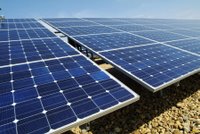Organic solar cells in plain english--part two
Alrightie. Knowing how the organic solar cell is made and how it works[1] allows us to figure out how to make it work better. In order to build a better solar cell, though, it might be a good idea to figure out what's wrong with the ones we're making now.
Here's a shot of a rather large solar array, courtesy of DuPont. Of course, these are crystalline silicon, which is not terribly interesting (to an organic chemist). Apart from the obvious problem of not being carbon-based, silicon is DAMNED EXPENSIVE, because it's also used for so many other electronics applications. Scads of demand for silicon. Also, you have to take into account that the silicon has to be processed in order to be useful. (What's in this picture is not useful.)

The equipment needed to process it is also DAMNED EXPENSIVE. In order to be useful, it has to be extremely pure. Carbon-based materials, likewise, also have to be pure in order to be useful. Otherwise, there are traps, which stabilize the charge carriers (electrons? holes? remember?)...if the charge carriers are stabilized by something in a particular spot, they become localized, and they don't move[2]. Low charge carrier mobility means your device does not work so well. Organic materials, unlike silicon, are not so hard to purify (unless you are required to purify something for an undergraduate lab course). You certainly don't need a clean room for it. Carbon-based materials are also not DAMNED EXPENSIVE (arguably).
Think about the solar panels normal people see on a daily basis. How often have you had a calculator die because its little solar strip quit working? Never? Even after years and years of abuse? There it is. Organic solar cells die young. Device lifetimes are really pretty miserable at this point.
Or: Device lifetimes would be a lot better, if we kept them under dry nitrogen forever and ever...and maybe in the dark as well...
You'll find out why in the next post. It's really too exciting for me to cut short, and I don't really want to make today's update four times longer than it is already.
[2] Sorry, but "in plain english" means I don't have to go into solid-state physics. While I can translate chemistry to english, I can't do the same for physics.

1 comment:
Hey, have you seen Hoffman's "Solids and Surfaces: A Chemist's View of Bonding in Extended Structures"? It's pretty short, it is only barely mathematical, and it really does explain SS physics via orbitals like we chemists think of them. After that, Tanner's "Introduction to the Physics of electrons in solids" is approachable though much more math-y.
I have fiddled around with solar cells in doing work on soluble acenes, and I went as far as post doc'ing in a solid state physics group to learn more about organic crystalline materials (which I focused on rather than polymers).
I did learn a lot, though I think most chemists who want to make useful stuff could stop well short of what I did. Learning the lingo, a little about k-space, and so on, makes it possible to collaborate with smarties from phyiscs and EE who can do some kickass measurements for you, in my experience. And it helps you steal ideas from them, too. If you can follow what the hell they are saying, it is almost inevitable that as a chemist, you'll start thinking of reasonable targets based on their work. And they can't synthesize squat, so they'll love you for it.
This is a great blog.
Post a Comment